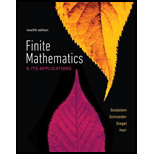
Concept explainers
In Exercises 1–22, use Bayes’ theorem to calculate the probabilities.
Accident Rates An automobile insurance company has determined the accident rate (probability of having at least one accident during a year) for various age groups. (See Table 2.) Suppose that a policyholder calls in to report an accident. What is the probability that they are over 60?
Table 2
Age Group |
Proportion of Total Insured |
Accident Rate |
Under 21 21–30 31–40 41–50 51–60 Over 60 |
.05 .10 .25 .20 .30 .10 |
.06 .04 .02 .015 .025 .04 |
Want to see the full answer?
Check out a sample textbook solution
Chapter 6 Solutions
Finite Mathematics & Its Applications (12th Edition)
Additional Math Textbook Solutions
Elementary Statistics: A Step By Step Approach
Elementary Algebra For College Students (10th Edition)
Beginning and Intermediate Algebra
Elementary Statistics
Finite Mathematics for Business, Economics, Life Sciences and Social Sciences
University Calculus: Early Transcendentals (4th Edition)
- 18.9. Let denote the boundary of the rectangle whose vertices are -2-2i, 2-21,2+i and -2+i in the positive direction. Evaluate each of the following integrals: L₁ = 2- (a). dz, (b). (d). ₁ = 22+2 [ dz, (e). √, z COS 2 dz dz, (c). L (2z+1)2dz, z(z+1)' (1). [e² si 1 sin z+ dz. (22+3)2arrow_forwardQ1: For, 0 <|z| < 1, evaluate the following integral where g is ana 9(5) inside and on the unit circle C: a) Sc - α) δε 915 αξί b) Sc d. -1/2 Llc functionarrow_forward纟 W₂ Find S-FX SB.MXarrow_forward
- Q4: Find the value of fydz, where y is given in the figure. A B 2arrow_forward4. The revenue (in thousands of dollars) from producing x units of an item is R(x)=8x-0.015 x². a) Find the average rate of change of revenue when the production is increased from 1000 to 1001 units.arrow_forwardMATH 122 WORKSHEET 3 February 5, 2025 . Solve the following problems on a separate sheet. Justify your answers to earn full credit. 1. Let f(x) = x² - 2x + 1. (a) Find the slope of the graph of y = f (x) at the point P = (0,1) by directly evaluating the limit: f'(0) = lim ( f(Ax) - f(0) Ax Ax→0 (b) Find the equation of the tangent line 1 to the graph of ƒ at P. What are the x and y intercepts of 1 ? (c) Find the equation of the line, n, through P that is perpendicular to the tangent line l. (Line n is called the normal line to the graph of f at P.) (d) Sketch a careful graph that displays: the graph of y = f (x), its vertex point, its tangent and normal lines at point P, and the x and y intercepts of these lines. Bonus: Find the coordinates of the second point, Q, (QP), at which the normal line n intersects the graph of f. 2. A rock is thrown vertically upward with an initial velocity of 20 m/s from the edge of a bridge that is 25 meters above a river bed. Based on Newton's Laws of…arrow_forward
- 1 If ye y = sin x, find dy/dx and dy/dx² at (0, 0).arrow_forward3. Use the graph for problem #35, p175 to answer the questions. The average price (in cents) per gallon of unleaded gasoline in the United States for the years 2010 to 2019 is shown in this chart. Find the average rate of change per year in the average price per gallon for each time period. Source: U.S. Energy Information Administration. a) 2010 to 2013 b) 2012 to 2018 c) 2014 to 2019arrow_forward4. Researchers at Iowa State University and the University of Arkansas have developed a piecewise function that can be used to estimate the body weight (in grams) of a male broiler during the first 56 days of life according to W(t)=48+3.64t+0.6363²+0.00963 t³ if 1St≤28, -1004+65.8t if 28arrow_forward3. Given the function h(x)=(x²+x-12 if x≤1 3-x if x>1' a) Graph the function h(x). Make the graph big enough to be easily read using the space below. Be sure to label all important aspects of the graph. b) Find all values of x where the function is discontinuous. c) Find the limit from the left and from the right at any values of x found in part b.arrow_forward2. Find the instantaneous rate of change for each function f(x)=2x²-x+3 at x=0..arrow_forward4x-3 2. Determine the interval over which the function is continuous. x+4arrow_forwardarrow_back_iosSEE MORE QUESTIONSarrow_forward_ios
 Holt Mcdougal Larson Pre-algebra: Student Edition...AlgebraISBN:9780547587776Author:HOLT MCDOUGALPublisher:HOLT MCDOUGAL
Holt Mcdougal Larson Pre-algebra: Student Edition...AlgebraISBN:9780547587776Author:HOLT MCDOUGALPublisher:HOLT MCDOUGAL
 Algebra and Trigonometry (MindTap Course List)AlgebraISBN:9781305071742Author:James Stewart, Lothar Redlin, Saleem WatsonPublisher:Cengage Learning
Algebra and Trigonometry (MindTap Course List)AlgebraISBN:9781305071742Author:James Stewart, Lothar Redlin, Saleem WatsonPublisher:Cengage Learning College AlgebraAlgebraISBN:9781305115545Author:James Stewart, Lothar Redlin, Saleem WatsonPublisher:Cengage Learning
College AlgebraAlgebraISBN:9781305115545Author:James Stewart, Lothar Redlin, Saleem WatsonPublisher:Cengage Learning




